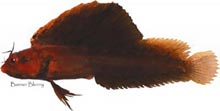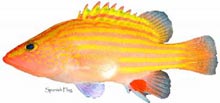
The Spanish flag (Gonioplectrus hispanus), a piscivorous grouper from the Flower Garden Banks. This fish resides on deep, shelf-edge reefs throughout the Gulf of Mexico and Atlantic Ocean. Click image for larger view.
The Wondrous World of Deep Reef Fishes
September 30, 2003
Doug Weaver
Flower Garden Banks National Marine Sanctuary, NOAA
OK, I’ll admit it: I'm hooked on fish.
Fish are wonderful, and there are lots of them! There are between 25,000 and 40,000 kinds, with scientists around the world discovering new species every day. They come in all colors, shapes, and sizes, and display an amazing array of behaviors. They live in cold mountain streams, broad meandering rivers, exposed mud flats, coastal seagrass beds, tropical coral reefs, and in the deep oceans down to the submarine trenches (over 7 mi deep!). Some climb trees, others breathe air, and a few even produce electricity.
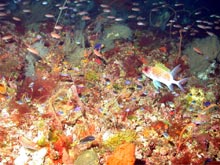
Diversity on the deep reef. Over 200 species of coral reef fish occur in the northwestern Gulf of Mexico, and many of these species occur on deep reefs. How many different kinds of fish can you find in this photograph from the deep-reef community of West Flower Garden Bank? Click image for larger view. Click here to view answer.
I‘ve had a lifelong fascination with fishes, and deep reef fishes are particularly interesting, because so little is known about them. As a research biologist at the Flower Garden Banks National Marine Sanctuary, my job is to explore the deep areas of the sanctuary, map reef fish habitats, and identify the fishes that occur there.
Many kinds of reef fish live beyond the depths at which it is safe to scuba dive, and we must use ROVs (remotely operated vehicles) and manned submersibles to conduct censuses of marine life. As advanced technology has become available in the form of cameras, sampling equipment, and remote sensing (including multibeam echosounders and sidescan sonars for sea floor mapping), these new types of equipment have resulted in the discovery of new types of fish in the sanctuary, including new distribution records and the discovery of fish species unknown to science.
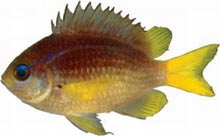
The yellowtail reef fish (Chromis enchrysura) is a plankton-eating damselfish that lives on shallow and deep coral reefs of the Atlantic Ocean and Gulf of Mexico. Click image for larger view.
Reef Fish Diversity
While more than 200 kinds of reef fish are present at the Flower Garden Banks National Marine Sanctuary, the numerically dominant species are represented by only a few families. Serranids, or sea basses, are the most common family of fish on shallow and deep reefs. Shallow coral reefs and banks have large schools of creolefish, a midwater-dwelling grouper. Other groupers (subfamily Epinephinelinae) present in the sanctuary include the yellowmouth grouper, tiger grouper, black grouper, rock hind, marble grouper, scamp, snowy grouper, and Warsaw grouper. Warsaw grouper are the biggest reef fish in the sanctuary. They can grow to a length of 7 ft and tip the scales at more than 500 lbs!
Other common species of sea bass are the small streamer basses (subfamily Anthiinae), which include the roughtongue bass, threadnose bass, and red barbier. Streamer basses form large schools that hover above deep patch reef and other reef outcrops, and are the most numerous reef fish within the sanctuary. Basslets (subfamily Serraninae), including the wrasse bass and tattler, are small, bottom-dwelling fish that live on coral reefs or in the sand adjacent to patch reefs.
Other common reef fishes include the damselfishes (family Pomacentridae). Shallow-water damselfishes, such as threespot damsels and cocoa damselfish, defend territories among coral colonies on the top of the banks. Deep-water damselfishes include the yellowtail reef fish, purple reef fish, and sunshinefish. These fish form large schools along reef walls and deep patch reefs. Other common deep-reef fish families in the northwestern Gulf include angelfish, butterflyfish, triggerfish, pufferfish, squirrelfish, cardinalfish, and bigeyes. Reef fish diversity decreases with depth, and few species occur at depths below 300 ft.

The red hogfish, a medium-sized wrasse occurring on deep coral reefs feeds on small crabs, shrimps, and other bottom-dwelling invertebrates. Click image for larger view.
Reef Fish Diets
Reef fish come in many shapes and sizes, and feed on a wide variety of items. Most of the fish that live on deep reefs are plankton eaters (planktivores). They depend on ocean currents to bring copepods, larvaceans, larval shrimps and crab larvae to the reef. Many species, such as the spotfin hogfish, cubbyu, and red porgy subsist on adult crabs, shrimp, and other bottom-dwelling creatures that live on rocks, corals, and in sandy sediments. Other species, such as the blue angelfish and reef butterflyfish, take bites of sessile invertebrates such as sponges, soft corals, and bryozoans, grazing like cows on underwater pastures. Many of the larger sea basses and snappers are fish eaters (piscivores). They feed on the smaller reef-dwelling planktivores and on other fish.
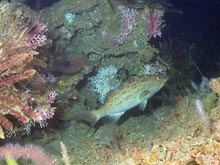
A juvenile scamp (Mycteroperca phenax) on a deep patch reef at West Flower Garden Bank. Water depth is 310 ft. Click image for larger view.
Reef Fish Surveys
Reef fish surveys conducted at the Flower Garden Banks National Marine Sanctuary are usually done by teams of volunteer divers using Nitrox scuba and underwater video or still cameras. Beyond 130 ft, however, surveys are usually conducted with an ROV equipped with still and video cameras, a manipulator arm, and a suction sampler to collect specimens. When available, manned submersibles are used to explore the deep areas of the sanctuary and the surrounding deep corals reefs. Sanctuary staff members are trained as pilots of the Deepworker 2000 research submersible, and have conducted survey dives at various banks of the northwestern Gulf. These surveys have resulted in detailed benthic habitat maps of the sanctuary and neighboring banks, and comprehensive lists of reef fishes, invertebrates, and algae that occur in the sanctuary. This information will assist sanctuary managers with decisions concerning the possible establishment of no-fishing zones and with implementing other regulations ti conserve the diverse fish populations in these unique coral reef communities.
Author’s Note: The fish illustrations in this log were produced from digital still photographs of prepared scientific specimens collected from the Gulf of Mexico. Raw digital images were imported into Adobe Photoshop™ software and cropped from the photographic background. Fish images were then cleaned of blemishes, filtered, sharpened, and enhanced to match the vibrant colors present on living individuals, while preserving anatomical accuracy. Images © 2003 Doug Weaver and the Flower Garden Banks National Marine Sanctuary, NOAA.























